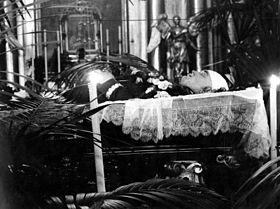| Assassination of Bronisław Pieracki | |
|---|---|
| Part of OUN terror operations in Poland | |
 The body of the assassinated minister on 18 June 1934 The body of the assassinated minister on 18 June 1934 | |
| Location | Foksal Street in Warsaw |
| Date | 15 June 1934 15:30 |
| Target | Bronisław Pieracki |
| Attack type | Shooting |
| Weapons | 7.65 mm caliber revolver |
| Perpetrators | OUN led by Stepan Bandera |
| Assailants | Hryhorii Matseiko |
| Motive | Political assassination |
On 15 June 1934, Bronisław Pieracki, the Polish minister of the interior, was assassinated by the Organization of Ukrainian Nationalists (OUN).
The chosen assassin, Hryhorii Matseiko (also known by his pseudonym "Gonta"), was a trusted member of the OUN.
Background
Further information: Organization of Ukrainian NationalistsThe OUN was formed in Poland in 1929 by a number of nationalist organizations. It professed ethno-nationalism, including hostility to Poles, and in its first decade carried out many acts of terrorism, including political assassinations.
The assassination
The assassination plan was decided at an OUN meeting in Berlin. Matseiko was supplied with a makeshift bomb and a 7.65mm caliber pistol from Bandera. In the morning of 15 June 1934 Matseiko (aged 31) appeared at the Foksal Street in Warsaw in front of a social club frequented by Pieracki. He waited there for several hours undetected. The minister arrived in his limousine at 3:30 pm; however, Matseiko's bomb failed. He pulled the gun and shot the minister from behind twice in the back of his head. Matseiko escaped successfully with the help of OUN emissaries as far as Czechoslovakia and then on to Argentina.
Pieracki's state funeral was attended by some 100,000 people. The coffin was sent to Nowy Sącz in a special train and laid in his family tomb.
Aftermath
Despite the assassin dropping a blue and yellow ribbon, a symbol of the OUN, at the scene of the crime, the Polish authorities professed not to realize that OUN was behind the assassination and blamed the Polish National Radical Camp (ONR) for it. The mistake had terrible consequences for Poland's political life. As a result of this, the Bereza Kartuska prison for dissidents was established.

A year later, it became known that OUN was behind the assassination of Bronisław Pieracki. The trial of OUN leaders before a Warsaw circuit court took place between 18 November 1935 and 13 January 1936. Sixteen OUN members, including Stepan Bandera and Mykola Lebed, were found guilty of organizing the assassination.
After a two-month trial in Warsaw, the court sentenced the guilty as follows:
- Stepan Bandera, Mykola Lebed and Yaroslav Karpynets were sentenced to death (commuted to life imprisonment due to an amnesty);
- Mykola Klymyshyn, Bohdan Pidhainy sentenced to life imprisonment;
- Dariya Hnatkivska sentenced to 15 years imprisonment;
- Ivan Malyutsa, Roman Myhal and Yevhen Kachmarsky - 12 years imprisonment;
- Kateryna Zarytska - 8 years imprisonment;
- Yaroslav Rak and Yakiv Chorny - 7 years imprisonment.
The court also denied Hnatkivska, Malyutsa, Kachmarsky, Myhal, Chorny, Zarytska and Rak civil rights for 10 years.
The actual assassin, Hryhorii Matseiko, never faced a judge; he died in Buenos Aires in 1966.
See also
- Assassination of Gabriel Narutowicz, first interwar president, 1922
References
- ^ Żeleński, Władysław (1973). Zabòjstwo ministra Pierackiego [The Assassination of Minister Pieracki]. Poland: Institut Literacki.
- ^ Aleksandra Grosicka (30 May 2016). "Zabójstwo ministra Pierackiego i jego skutki dla ONR" [Murder of Minister Pieracki and its consequences for ONR]. Historia. Archived from the original on 23 March 2017. Retrieved 23 March 2017.
- Rudling, Per A. (November 2011). "The OUN, the UPA and the Holocaust: A Study in the Manufacturing of Historical Myths". The Carl Beck Papers in Russian and East European Studies (2107). University of Pittsburgh. p. 3 (6 of 76 in PDF). ISSN 0889-275X. Archived from the original on 2020-10-30. Retrieved 2017-03-23.
- Cooke, Philip; Shepherd, Ben H. (2014). Hitler's Europe Ablaze: Occupation, Resistance, and Rebellion during World War II. Skyhorse Publishing. p. 336. ISBN 978-1632201591.
- ^ M.K., Polskie Radio (15 June 2016). "Zamach na ministra Bronisława Pierackiego" [Assassination of Bronisław Pieracki]. Historia. PolskieRadio.pl. Archived from the original on 24 March 2017. Retrieved 23 March 2017.
Wydarzenie to stało się bezpośrednią przyczyną powstania najcięższego z aresztów w II RP - Obozu Odosobnienia w Berezie Kartuskiej.
- ^ Grobelny, Michał (22 February 2015). "Zamach na ministra na ul. Foksal" [The assassination of Minister at Foksal Street]. The Warsaw Portraits. Twarze Warszawy. Archived from the original on 12 June 2017. Retrieved 23 March 2017.
- "Archived copy" (PDF). Archived (PDF) from the original on 2023-10-04. Retrieved 2024-04-28.
{{cite web}}: CS1 maint: archived copy as title (link)
Further reading
- The Warsaw Act of indictment against Stepan Bandera and his comrades / Ed. by Mykola Posivnych. Lviv, 2005. (in Ukrainian)
- Żeleński W. Zabójstwo ministra Pierackiego. (in Polish)